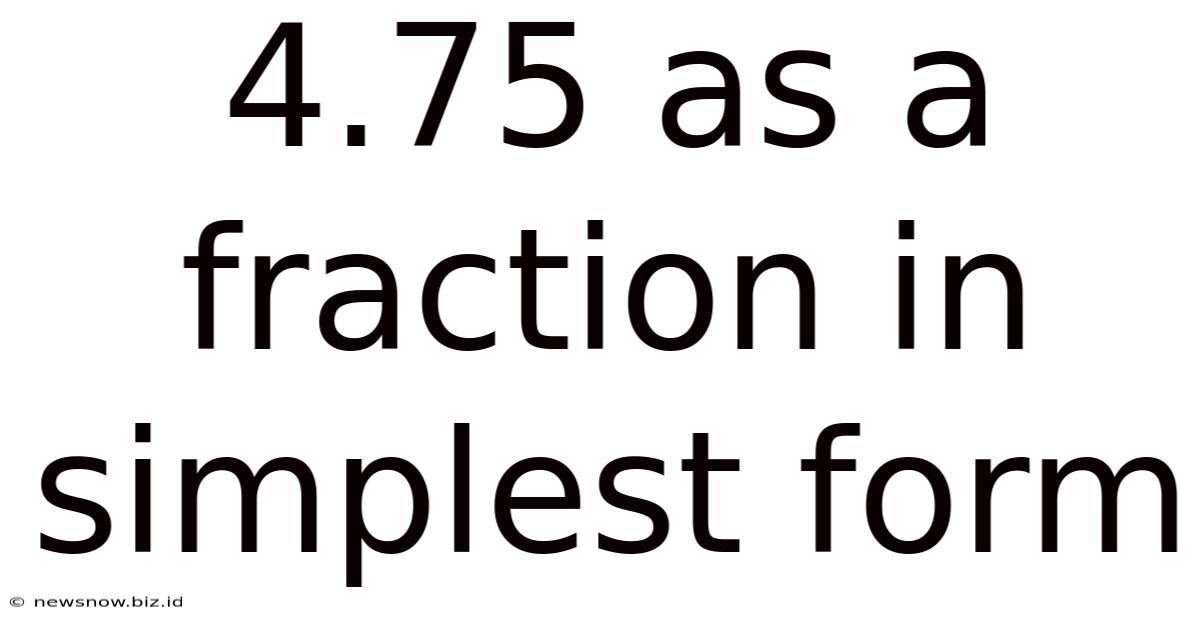4.75 As A Fraction In Simplest Form
New Snow
May 10, 2025 · 4 min read

Table of Contents
4.75 as a Fraction in Simplest Form: A Comprehensive Guide
Converting decimals to fractions might seem daunting at first, but with a structured approach, it becomes a straightforward process. This comprehensive guide will walk you through converting 4.75 into its simplest fractional form, explaining each step in detail and providing additional examples to solidify your understanding. We'll also explore the underlying mathematical principles and delve into various applications of this conversion.
Understanding Decimals and Fractions
Before we begin, let's clarify the relationship between decimals and fractions. Decimals represent parts of a whole using a base-ten system, where each digit to the right of the decimal point represents a power of ten (tenths, hundredths, thousandths, and so on). Fractions, on the other hand, express parts of a whole as a ratio of two integers – a numerator (top number) and a denominator (bottom number).
The core idea behind converting a decimal to a fraction lies in understanding the place value of each digit in the decimal. The decimal 4.75 consists of a whole number part (4) and a fractional part (0.75).
Converting 4.75 to a Fraction: Step-by-Step
Step 1: Identify the place value of the last digit.
In 4.75, the last digit (5) is in the hundredths place. This means the decimal represents 75 hundredths.
Step 2: Write the decimal as a fraction.
Based on Step 1, we can write 4.75 as the fraction 75/100. This fraction represents the fractional part (0.75) of the decimal. Remember that 4.75 is not just 0.75 but it's 4 plus 0.75. So, now we add the whole number back in.
Step 3: Add the whole number.
To include the whole number part (4), we add 4 to the fractional part: 4 + 75/100. To represent this sum as a single fraction, we need to convert the whole number to a fraction with a denominator of 100. This is done by multiplying 4 by 100/100, resulting in 400/100.
Step 4: Combine the whole number fraction and fractional part.
Now, we combine the two fractions: 400/100 + 75/100 = 475/100. This gives us the initial fractional representation of 4.75.
Step 5: Simplify the fraction.
This fraction, 475/100, is not yet in its simplest form. To simplify, we need to find the greatest common divisor (GCD) of the numerator (475) and the denominator (100). The GCD is the largest number that divides both 475 and 100 without leaving a remainder. In this case, the GCD is 25.
Step 6: Divide both the numerator and the denominator by the GCD.
Dividing both 475 and 100 by 25, we get:
475 ÷ 25 = 19 100 ÷ 25 = 4
Therefore, the simplest form of 4.75 as a fraction is 19/4.
Alternative Method: Using the Place Value Directly
Another approach is to directly use the place value to represent the decimal as a fraction. Since 4.75 has two digits after the decimal point, it's in the hundredths place. Therefore, we can directly write it as 475/100. Then, follow steps 5 and 6 (simplification) as described above to reach the simplest form, 19/4.
Verifying the Result
To verify our result, we can convert the fraction 19/4 back to a decimal. We perform the division: 19 ÷ 4 = 4.75. This confirms that our conversion is correct.
Practical Applications of Decimal-to-Fraction Conversions
The ability to convert decimals to fractions is crucial in various fields:
- Mathematics: Solving equations, simplifying expressions, and working with rational numbers.
- Engineering: Precision measurements and calculations in design and construction.
- Cooking and Baking: Precise measurement of ingredients.
- Finance: Calculating interest rates and percentages.
- Science: Data analysis and representation in experiments and research.
Further Examples
Let's solidify our understanding with more examples:
Example 1: Converting 2.25 to a fraction
- Identify the place value: hundredths
- Write as a fraction: 225/100
- Simplify: Divide by 25 (GCD) -> 9/4
Example 2: Converting 0.625 to a fraction
- Identify the place value: thousandths
- Write as a fraction: 625/1000
- Simplify: Divide by 125 (GCD) -> 5/8
Example 3: Converting 3.125 to a fraction
- Identify the place value: thousandths
- Write as a fraction: 3125/1000
- Simplify: Divide by 125 (GCD) -> 25/8
Dealing with Repeating Decimals
Converting repeating decimals to fractions requires a different approach involving algebraic manipulation. We won't cover that here, but it's a valuable skill to learn for a comprehensive understanding of number systems.
Conclusion
Converting decimals like 4.75 to their simplest fractional form (19/4) is a fundamental mathematical skill with wide-ranging applications. By following the steps outlined in this guide, you can confidently convert any decimal to a fraction, enhancing your mathematical proficiency and problem-solving abilities. Remember to always simplify your fraction to its lowest terms for the most concise and accurate representation. Practice with various examples to build your confidence and mastery of this important skill. The more you practice, the more intuitive and easy this conversion process will become. Understanding the underlying principles of place value and greatest common divisors is key to mastering this important mathematical concept.
Latest Posts
Related Post
Thank you for visiting our website which covers about 4.75 As A Fraction In Simplest Form . We hope the information provided has been useful to you. Feel free to contact us if you have any questions or need further assistance. See you next time and don't miss to bookmark.